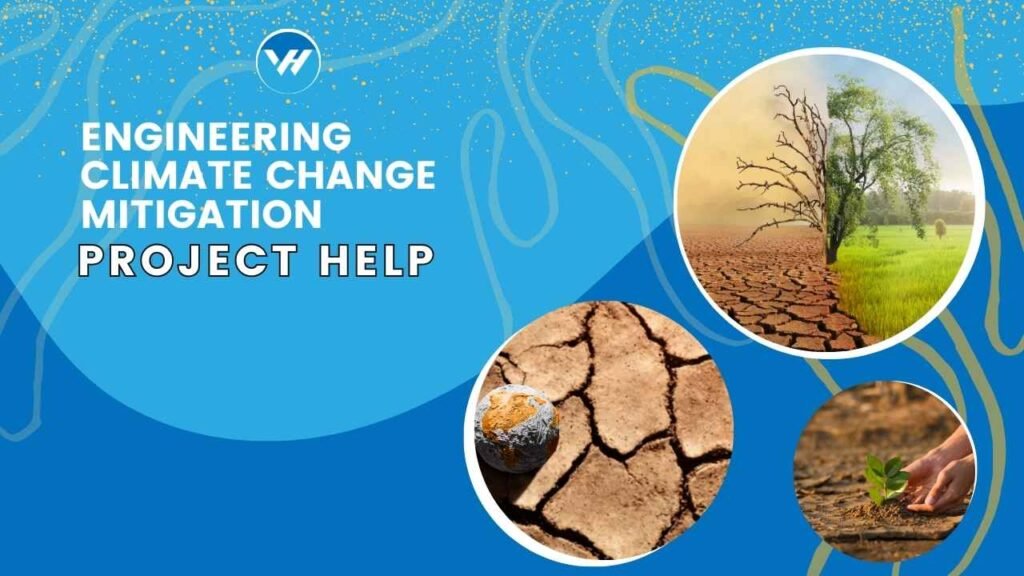Climate change is one of the most pressing global issues of our time, with far-reaching impacts on the environment, economies, and societies. Engineering plays a critical role in addressing climate change by developing and implementing innovative solutions to reduce greenhouse gas emissions and enhance sustainability. In this article, we’ll explore various engineering projects aimed at climate change mitigation and how students can get help with these projects through Virtual Help.

Table of Contents
ToggleUnderstanding Climate Change Mitigation
Climate change mitigation refers to efforts to reduce or prevent the emission of greenhouse gases. The goal is to limit the magnitude of future climate change and its adverse effects. Key strategies for climate change mitigation include transitioning to renewable energy, improving energy efficiency, capturing and storing carbon dioxide, and enhancing sustainable practices across various sectors.
Role of Engineers in Climate Change Mitigation
Engineers are at the forefront of developing technologies and systems to combat climate change. Their contributions range from designing renewable energy systems to creating energy-efficient buildings and developing sustainable transportation solutions. Let’s delve into some specific engineering projects that focus on climate change mitigation.
Renewable Energy Projects
Solar Power Projects: Engineers design and install solar panels that convert sunlight into electricity. Solar farms and rooftop solar installations are common projects that significantly reduce reliance on fossil fuels.
Wind Energy Projects: Wind turbines harness the power of wind to generate electricity. Engineers work on designing efficient wind turbines and optimizing their placement for maximum energy production.
Hydroelectric Power Projects: Hydropower plants use flowing water to generate electricity. Engineers are involved in designing dams, turbines, and other infrastructure needed for these projects.
Energy Efficiency Projects
Building Energy-Efficient Structures: Engineers design buildings with improved insulation, energy-efficient windows, and sustainable materials to reduce energy consumption.
Retrofitting Existing Buildings: Upgrading old buildings with modern, energy-saving technologies can significantly cut energy use. This includes installing better heating, ventilation, and air conditioning (HVAC) systems.
Industrial Energy Efficiency: Engineers work on optimizing industrial processes to reduce energy waste and improve overall efficiency.
Carbon Capture and Storage (CCS) Projects
Overview of CCS Technology: Carbon capture and storage involve capturing carbon dioxide emissions from industrial sources and storing them underground to prevent them from entering the atmosphere.
Current CCS Projects and Their Impact: Engineers design and implement CCS projects, which are crucial for reducing emissions from sectors like power generation and heavy industry.
Sustainable Transportation Projects
Electric Vehicles and Infrastructure: Engineers design electric vehicles (EVs) and the necessary charging infrastructure to support their widespread adoption.
Public Transportation Improvements: Enhancing public transportation systems can reduce the number of cars on the road, lowering overall emissions.
Sustainable Urban Planning: Designing cities to be more walkable and bike-friendly reduces the need for car travel and promotes sustainable living.
Water Management Projects
Sustainable Water Use and Conservation: Engineers develop systems for efficient water use, reducing wastage in agriculture, industry, and households.
Desalination Projects: Desalination plants convert seawater into freshwater. Engineers work on making these plants more energy-efficient and environmentally friendly.
Wastewater Treatment and Reuse: Treating and reusing wastewater reduces the demand for fresh water and minimizes environmental pollution.
Agricultural Engineering Projects
Sustainable Farming Practices: Engineers develop techniques for sustainable agriculture, such as precision farming and integrated pest management.
Soil Carbon Sequestration: Methods like no-till farming and cover cropping help capture carbon in the soil, reducing atmospheric CO2 levels.
Precision Agriculture: Using technology to optimize farming practices increases efficiency and reduces environmental impact.
Forestry and Land Use Projects
Reforestation and Afforestation: Planting trees and restoring forests capture carbon dioxide and improve biodiversity.
Sustainable Land Management: Engineers develop strategies for sustainable land use that balance development and conservation.
Urban Green Spaces: Creating green spaces in urban areas helps reduce heat islands, improves air quality, and enhances residents’ well-being.
Waste Management Projects
Recycling and Waste Reduction: Engineers design systems for efficient recycling and waste management to minimize landfill use.
Waste-to-Energy Projects: Converting waste into energy reduces landfill waste and provides a renewable energy source.
Circular Economy Initiatives: Engineers develop systems that promote the reuse and recycling of materials, reducing overall waste.
Climate Resilience and Adaptation Projects
Building Climate-Resilient Infrastructure: Engineers design infrastructure that can withstand extreme weather events, such as floods and hurricanes.
Community-Based Adaptation Projects: Working with communities to develop localized solutions to climate change impacts.
Disaster Risk Reduction Engineering: Implementing engineering solutions to reduce the risk and impact of natural disasters.
Challenges in Engineering Climate Change Mitigation
Technical Challenges: Developing new technologies and systems requires significant research and innovation.
Financial and Economic Barriers: Funding for large-scale projects can be a major hurdle, as can economic considerations related to transitioning away from fossil fuels.
Policy and Regulatory Issues: Engineers must navigate complex regulations and policies that can impact the implementation of mitigation projects.
The Role of Virtual Help in Engineering Projects
Overview of Virtual Help and Its Services: Virtual Help offers a platform for students to connect with tutors and get assistance with their engineering projects.
How Virtual Help Can Assist Students with Climate Change Mitigation Projects: Providing expert guidance and resources to help students tackle complex engineering challenges.
Benefits of Using Virtual Help for Engineering Assignment Assistance: Access to experienced tutors, personalized support, and a wide range of resources.
Conclusion
Engineering is pivotal in the fight against climate change. By developing and implementing innovative solutions, engineers can significantly reduce greenhouse gas emissions and promote sustainability. For students working on climate change mitigation projects, Virtual Help offers valuable support to ensure their success. Together, we can build a sustainable future.
FAQs
What are the key strategies for climate change mitigation?
Key strategies include transitioning to renewable energy, improving energy efficiency, capturing and storing carbon dioxide, and enhancing sustainable practices across various sectors.
How do engineers contribute to climate change solutions?
Engineers develop technologies and systems such as renewable energy projects, energy-efficient buildings, and sustainable transportation solutions.
What are some examples of renewable energy projects?
Examples include solar power projects, wind energy projects, and hydroelectric power projects.
How can Virtual Help assist with engineering climate change mitigation projects?
Virtual Help provides expert guidance, personalized support, and a wide range of resources to help students tackle complex engineering challenges.
What are the challenges faced in engineering climate change mitigation?
Challenges include technical difficulties, financial and economic barriers, and navigating complex policies and regulations.





